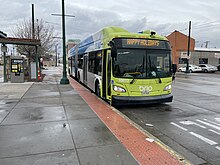 | ||||||
 A Brio bus at the downtown transit center A Brio bus at the downtown transit center | ||||||
| Overview | ||||||
|---|---|---|---|---|---|---|
| Operator | Sun Metro | |||||
| Vehicle | New Flyer Xcelsior XN60 | |||||
| Status | Operational | |||||
| Began service | October 27, 2014 (2014-10-27) | |||||
| Route | ||||||
| Route type | Bus rapid transit | |||||
| Locale | El Paso | |||||
| Length | 51.3 miles (82.6 km) | |||||
| Stations | 98 | |||||
| Service | ||||||
| Frequency | 10–15 minutes | |||||
| Weekend frequency | 20 minutes on Saturdays 25 minutes on Sundays | |||||
| ||||||
Brio is a bus rapid transit system in El Paso, Texas, United States. It is operated by Sun Metro.
The first line, the Mesa Corridor, began operating in the fall of 2014. This line is 8.6 miles (13.8 km) long and uses 22 purpose-built curbside stations with shelters, ticket vending machines for pre-boarding payment, and real-time arrival information. Two more corridors, Dyer (Northeast) and Alameda (Mission Valley) Corridors became operational in October 2018. The Montana Corridor, which serves the Eastside, opened on November 6, 2022.
Description
Each Brio corridor contains at least two transfer centers, where passengers can transfer between Brio and local buses. Outside of transfer centers, stops consist of curbside shelters with the following amenities:
- Free WiFi
- Translucent panels for better lighting
- Bike racks
- Shade screens
- Electronic real-time displays
- Ticket vending machine (TVM)
- Solar-powered compacting trash can
- Displays of unique public artwork
The Brio fleet consists of 60-foot-long (18 m) branded New Flyer Xcelsior articulated buses powered by compressed natural gas, able to carry 72 total passengers and feature on-board WiFi, interior bike racks, and passenger information monitors. Each bus also contains three doors to facilitate a quicker boarding process.
The vehicles operate in mixed traffic. Signal prioritization is used to lengthen green traffic signals and reduce delays. The frequency of Brio buses range from 10 minutes during weekday rush hours to 15 minutes mid-day from Monday to Friday, 20 minutes on Saturdays and 25 minutes on Sundays. Stations are located about a mile apart. Passengers can buy a one-way trip, a day pass, a weekly pass or a monthly pass from the ticket vending machine located at all permanent Brio stations. To prevent fare evasion, Brio Ambassadors will be monitoring and requesting proof of payment during trips on Brio.
Over 50,000 people use Brio every month, which has meant that approximately 20 tonnes of carbon dioxide was not emitted in the first year of its operation. Brio has also inspired new businesses; around 20 have been launched since Brio was launched as of 2016.
Naming the system
Sun Metro hired PAVLOV, a marketing communications company, to develop the system name and logo. The word Brio is Spanish for excitement, verve and energy.
The logo was designed to complement the circular nature of Sun Metro's current logo. The ‘b’ and ‘o’ in Brio are a graphic element that can be used to extend the identity of the RTS system. The movement within the logotype references the wheels on the vehicles. In addition to the name and logo, Sun Metro selected a color palette and graphic standards to make Brio stations and buses distinctive and easily recognizable.
Fares
Fares for Brio are the same as standard fare on other Sun Metro lines. Currently, the standard fare is $1.50, $1.00 for students, and $0.30 for seniors 65+, disabled and Medicare. Sun Metro also offers daily, weekly, and monthly passes for each fare category.
Lines
Mesa Corridor
- Length: about 8.6 miles (13.8 km)
- Beginning of route: Downtown Transfer Center
- End of route: Westside Transfer Center
- Total number of buses: 10
- Number of stations: 22
- Total project cost: $27.1 million
- FTA funding: $15.6 million
- TXDOT funding: $5.5 million
- Operational: currently operational
Alameda Corridor
- Length: 14.5 miles (23.3 km)
- Beginning of route: Downtown Transfer Center
- End of route: Mission Valley Transfer Center
- Total number of buses: 14
- Number of stations: 29
- Total construction project cost: $38.3 million
- Funding: 100 percent City of El Paso
- Operational: currently operational
Dyer Corridor
- Length: 11.4 miles (18.3 km)
- Beginning of route: Downtown Transfer Center
- End of route: Northeast Transfer Center
- Total number of buses: 10
- Number of stations: 22
- Total project cost: $35.9 million
- FTA funding (anticipated): $21.7 million
- TXDOT funding: $6.6 million
- Operational: currently operational
Montana Corridor
- Length: 16.8 miles (27.0 km)
- Beginning of route: Five Points Terminal
- End of route: Future Far East Side Transfer Center
- Total no. of buses: 14
- Number of stations: 25
- Total project cost: $47 million
- FTA funding (anticipated): $29.5 million
- TXDOT funding: $8 million
- Operational: currently operational
References
- Crowder, David (January 19, 2014). "Sun Metro Brio buses roll out in July". El Paso Inc. Retrieved December 12, 2017.
- ^ "Brio". Sun Metro.
- "Texas agency showcases new station, buses". Metro Magazine. May 27, 2014. Retrieved December 29, 2015.
- ^ Schroeder, Margaret; Asce, M.; Roberts, Chris (August 16, 2016). "BRT Benefits in El Paso". Mass Transit. Retrieved December 12, 2017.
- "Fares & Passes". Sun Metro. Retrieved October 20, 2021.
| Currently operating bus rapid transit systems in the United States | |||||||||||||||||||||||||||||||||||||||||||||||||||||||||
|---|---|---|---|---|---|---|---|---|---|---|---|---|---|---|---|---|---|---|---|---|---|---|---|---|---|---|---|---|---|---|---|---|---|---|---|---|---|---|---|---|---|---|---|---|---|---|---|---|---|---|---|---|---|---|---|---|---|
| |||||||||||||||||||||||||||||||||||||||||||||||||||||||||
